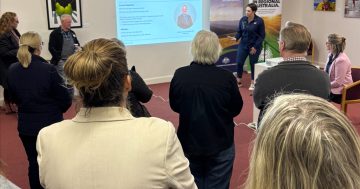
CRJO interim CEO Leanne Barnes and Resilience NSW Commissioner Shane Fitzsimmons at a recent workshop to discuss how to support councils in the region to become more resilient and disaster-ready. Photo: Claire Fenwicke.
The disaster resilience of councils across NSW will be put under the microscope in a series of workshops across the state.
This kicked off with Resilience NSW Commissioner Shane Fitzsimmons meeting with the Canberra Region Joint Organisation (CRJO) to examine its roadmap to readiness for whatever the future holds.
Commissioner Fitzsimmons said he wanted to understand the disaster resilience of each community as the draft State Resilience Strategy (SRS) was being developed.
“The SRS will define NSW’s collective vision for a state that’s resilient to natural hazards, underpinned by state-wide outcomes and goals,” he said.
“Recommendations from inquiries into the Black Summer bushfires showed we needed to lift resilience capacities and capabilities across councils, build those relationships and collaborate to understand the needs and priorities around what really matters to each community.”
The SRS also aimed to bring cohesion to resilience work across the state.
“Once finalised, it will guide and inform plans and decision-making across the state as we build stronger, more disaster-resilient communities,” Commissioner Fitzsimmons said.
“It has a natural hazards lens at the moment but it will grow beyond that. We’re looking at more intense and frequent disaster situations, so we need to understand capabilities at local levels, their needs and priorities and then organise ways to build on their interests.
“These discussions will ensure we capitalise on the knowledge and work established by NSW councils, are informed by the needs of local communities and support councils to build and embed resilience.”
The CRJO encompassed 10 member councils across NSW: Bega Valley, Hilltops, Upper Lachlan, Eurobodalla, Queanbeyan-Palerang, Goulburn Mulwaree, Snowy Monaro, Snowy Valley, Wingecarribee and Yass Valley. It also covered three associate members: ACT Government, Wagga Wagga and East Gippsland in Victoria.
Commissioner Fitzsimmons acknowledged the region faced bushfires, floods, drought and hail but said the area’s challenges extended beyond natural disasters.
“You’ve then got COVID, growing populations, pressure on technology and communications, power and utilities,” he said.
“We’re identifying the vulnerabilities and weak points now and into the future to be prepared. It’s not just about today; it’s about tomorrow and how things are changing.”
Reactions to more uncommon disasters in the area were also being examined, including earthquakes, tsunamis and significant building collapses.
“From here, we can identify what can be done to prepare, everything from no-cost actions such as simple awareness, to more significant investments such as levy banks, relocating facilities and strengthening buildings,” Commissioner Fitzsimmons said.
As part of the workshop, the CRJO presented its Resilience Blueprint for South East NSW which was funded through bushfire grants at both state and federal levels.
CRJO interim CEO Leanne Barnes said they focused on climate risks, change and adaptations and what impact certain disasters would have on each council area.
“We’ve examined climate risk analysis and projections, the history of disasters, how they could become more frequent in the future as well as local experiences,” she said.
“While it was funded through the bushfire program, we certainly also needed to examine flood potential in terms of planning.”
This will be collated into a “tool kit” of resilience action options and strategies to assist council planning and decision-making.
“It will support councils to move to better practice across infrastructure, building better, land use planning, emergency planning and preparedness, working with communities and other sectors to improve capacity and capability,” Ms Barnes said.
“As well, it will help provide greater clarity on emergency preparedness, recovery roles and responsibilities and increase efficiencies and cost savings in delivering resilient infrastructure and services.”
The blueprint will be available from July with funding to roll out projects on the ground until June 2023.
Ms Barnes said she hoped it would mean councils could be more proactive rather than reactive the next time a disaster hit any region.
“We can be so tied up in responding to rolling disasters; we need to plan and prepare now so we can be more aware of the future,” she said.
Workshops continue across the state for eight weeks, with the SRS to be open for public consultation in August.








